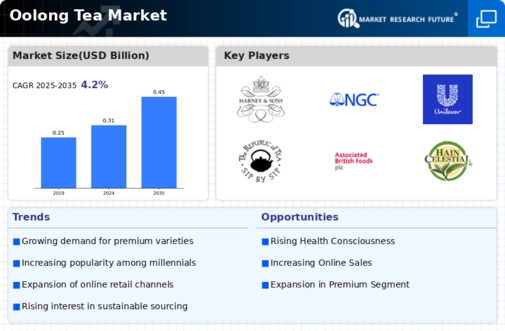Top Industry Leaders in the Oolong Tea Market
Strategies Adopted by Oolong Tea Key Players
The competitive landscape of the oolong tea market is marked by a blend of traditional players, regional specialists, and the emergence of new entrants, all striving to secure a significant share in this dynamic segment of the beverage industry. Key players, through strategic maneuvers and targeted approaches, navigate the nuances of consumer preferences, regional variations, and health-conscious trends to maintain or enhance their market positions.
Key Players:
ESP Tea Emporium
The Republic of Tea
Harney & Sons
Associated British Foods
The Mighty Leaf Tea Company
Tata Global Beverages Limited
Unilever
Hain Celestial
Bigelow Tea Company
Ceylon Organic Ltd
Strategies adopted by key players in the oolong tea market revolve around product quality, branding, and market expansion. Oolong tea, known for its nuanced flavors and potential health benefits, is often positioned as a premium beverage. Companies focus on maintaining or improving the quality of their tea leaves through sustainable sourcing and processing methods. Taiwan Tea Corporation, for instance, emphasizes its commitment to high-quality oolong teas, cultivating a reputation for excellence.
Marketing and branding efforts are essential to differentiate products and build brand loyalty. Companies invest in conveying the unique characteristics of their oolong teas, emphasizing the origin, processing techniques, and flavor profiles. Dilmah Ceylon Tea Company, recognized for its ethical sourcing practices, strategically positions its oolong teas as part of a broader commitment to sustainability and authenticity.
Market expansion is pursued through a combination of distribution partnerships and product diversification. Ten Ren Tea Co., with a significant presence in Asia, strategically expands its reach through collaborations with retailers and online platforms, ensuring accessibility to a wider consumer base. These strategies collectively aim to capture the attention and preference of diverse consumer segments.

Market Share Analysis:
Market share analysis in the oolong tea market is influenced by various factors, including product quality, pricing, brand recognition, and regional presence. Quality remains a critical factor, as consumers seek authentic and well-crafted oolong teas. Pricing strategies must strike a balance between perceived value and affordability, with companies often positioning their products as premium offerings to align with consumer perceptions of oolong tea.
Brand recognition plays a crucial role, particularly for global players. Established brands benefit from consumer trust and loyalty built over the years. The ability to adapt to regional preferences and cultural nuances is also a key factor, as oolong tea consumption varies across different markets. Companies that effectively tailor their offerings to local tastes and preferences gain a competitive edge in specific regions.
New and Emerging Companies:
The oolong tea market has witnessed the emergence of new and niche players, reflecting the beverage's growing popularity and evolving consumer preferences. Startups such as Floating Leaves Tea and Mountain Tea Co. focus on specialty oolong teas, carving a niche by offering unique and rare varieties. These companies often emphasize direct sourcing from tea gardens and transparent supply chains to appeal to discerning consumers seeking authenticity.
Industry Trends:
Recent trends in the oolong tea industry include a heightened emphasis on sustainability and health-conscious choices. Companies are increasingly investing in eco-friendly packaging and organic farming practices to align with consumer expectations for environmentally responsible and health-oriented products. Taiwan Tea Corporation, for instance, has announced initiatives to reduce its environmental footprint, reflecting a broader industry shift towards sustainability.
Moreover, the oolong tea market is witnessing increased investment in digital marketing and e-commerce channels. Companies are leveraging online platforms to reach a broader audience and facilitate convenient purchasing options. This trend is evident in the efforts of Fujian Guangdong Tea Import & Export Company, which has strengthened its online presence to meet the growing demand for oolong teas in the digital marketplace.

Competitive Scenario:
The overall competitive scenario in the oolong tea market reflects a delicate balance between heritage brands, regional specialists, and innovative newcomers. Established players draw on their historical expertise, while new entrants contribute fresh perspectives and niche offerings. The market's growth is fueled by increasing consumer interest in specialty teas, with oolong positioned as a premium and nuanced choice. The ability to adapt to changing consumer preferences, sustain quality, and navigate the complexities of global and regional markets shapes the competitive dynamics within the oolong tea industry.
Recent Development:
Drink-ready selections: Brands are introducing bottled oolong teas and tea extracts, making it simpler than ever to enjoy this tasty beverage on the move. Convenience is important.
Oolong has a distinct flavour profile that is between that of green and black tea. It entices the palate with a range of flowery, fruity, and toasted aromas.

